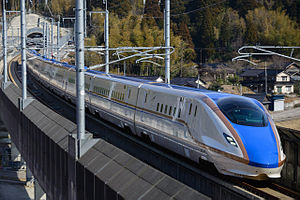Hokuriku Shinkansen
| Hokuriku Shinkansen | |||
|---|---|---|---|
|
|
|||

A JR West W7 series train on the Hokuriku Shinkansen
|
|||
| Overview | |||
| Native name | 北陸新幹線 | ||
| Type | Shinkansen | ||
| Status | Operational | ||
| Locale | Japan | ||
| Termini |
Takasaki Kanazawa |
||
| Operation | |||
| Opened | 1 October 1997 | ||
| Operator(s) |
|
||
| Depot(s) | Nagano, Hakusan | ||
| Rolling stock | E2 series, E7 series, W7 series | ||
| Technical | |||
| Track gauge | 1,435 mm (4 ft 8 1⁄2 in) | ||
| Minimum radius | 4,000 m | ||
| Electrification | 25 kV AC, 50/60 Hz, overhead catenary | ||
| Operating speed | 260 km/h (160 mph) | ||
|
|||
The Hokuriku Shinkansen (北陸新幹線?) is a high-speed shinkansen railway line jointly operated by East Japan Railway Company (JR East) and West Japan Railway Company (JR West), connecting Tokyo with Kanazawa in the Hokuriku region of Japan. The first section, between Takasaki and Nagano in Nagano Prefecture, opened on 1 October 1997, originally called the Nagano Shinkansen (長野新幹線?) (Takasaki is linked to Tokyo by the Joetsu Shinkansen). The extension to Toyama in Toyama Prefecture and Kanazawa in Ishikawa Prefecture opened on 14 March 2015. Construction of a further section onward to Fukui and Tsuruga in Fukui Prefecture commenced in 2012, with scheduled opening in fiscal 2022. The route of the final section to Shin-Osaka was decided on 20 December 2016 as the Obama - Kyoto route, with construction expected to begin in 2030 and take 15 years.
Since March 2015, services on the line are split into four types, with train names as listed below. Trains operate over the Joetsu and Tohoku Shinkansen tracks between Tokyo and Takasaki.
...
Wikipedia

